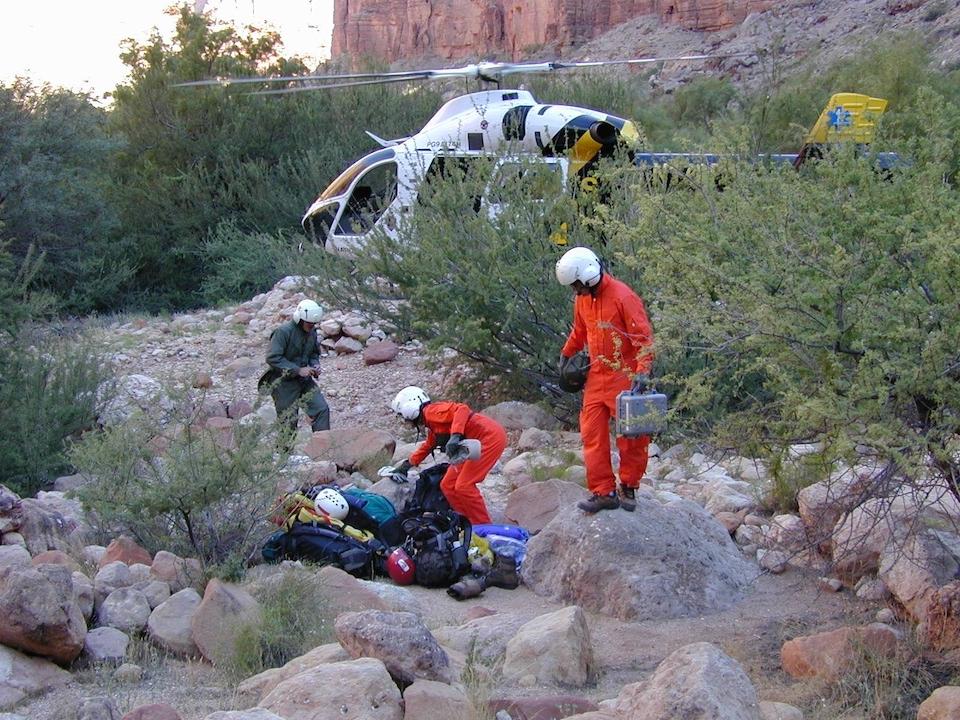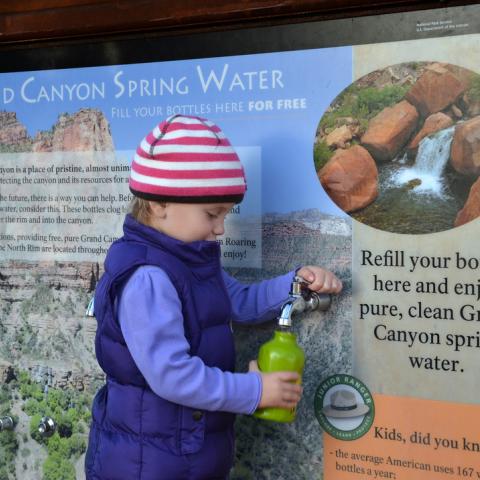
Grand Canyon National Park rangers ask that you go about your park hike recognizing the risks and able to self-rescue/NPS file
Pssst. Don't be stupid and turn into a statistic on your next hike at Grand Canyon National Park.
Last month there were nearly 300 ranger responses to hikers in need in the park. Specifically, rangers responded to 216 hiker assists, 51 search-and-rescue incidents, and 37 helicopter medical evacuations in the inner canyon.
"Many of these emergencies could have been prevented by hikers planning ahead, knowing their own physical abilities, and choosing appropriate hiking distances," a park release said.
With those stats in mind, park rangers urge inner canyon hikers to "hike smart while visiting the park this fall season. Hikers and backpackers attempting rigorous distances, such as ‘Rim to Rim’ through the inner canyon, are strongly encouraged to be self-reliant and to understand their own physical limitations in order to prevent emergency situations for themselves and responders."
"Rangers advise that anyone hiking needs to balance food and water intake, drink when thirsty, and watch for signs of distress in traveling companions," the park release said. "Visitors should be prepared to self-rescue while on the canyon's trails. Plan on taking twice as long to hike up as it takes to hike down. Allow a third of your time to descend and two-thirds of your time to ascend. Bring a lightweight flashlight in case you end up hiking in the dark and recreate responsibly at all times while visiting the park."
A backcountry permit is required for any overnight camping in the inner canyon. Information on obtaining a backcountry can be found at this website.




 Support Essential Coverage of Essential Places
Support Essential Coverage of Essential Places







Comments
With a family member who is a former NPS employee that worked in the Grand Canyon, I can attest to the fact that people can be really stupid in this regard. They had direct orders to not assist people in distress, only to call them in. The family member made the mistake of assisting a hiker in distress and was injured as a result. When the helicopter came, the hiker got taken out, not the employee. This was in the summer and load limits prevented additional people on the helicopter. The family member ended up losing paid time as a result while they recovered, too.
Many stories about people they saw who were not properly prepared for entering the Canyon, mostly for lack of water or proper clothing/shoes. Amazing there aren't more deaths and injuries.
As a former NOLS certified Wilderness First Responder, I can vouch for pretty much all of what King Kitty has posted above. I once watched, from far above, as a young woman from Japan was starting down one of the steep trails into the canyon. She was wearing a skimpy short cocktail dress, an elaborately embroidered shawl, the cutest little hat, and high heels and carrying no supplies whatsoever, no water, no food, no communications, nothing. The temperature was well into the high nineties and, even from a distance, I could tell her ankles were smaller than my wrists. I was called away and don't know how her visit turned out; but, I doubt it was good.
As for "direct orders to not assist people in distress, only to call them in" are concerned, NOLS actually trains first responders to rely on five principles when arriving at a rescue or recovery scene. The first principle is to remember that you, the responder, must think of yourself as "Number One" and this is not meant in any narcissistic sense. You're trained to take this attitude because 1) the last thing needed on the scene is another victim needing assistance, in which case you're then part of the problem rather than the solution; 2) if you injure yourself trying to rescue or help a victim, then you're ability to render further help to anyone, yourself or the victim, will be compromised; and 3) if, in taking a risk while trying to rescue or help a victim, you're seriously incapacitated, then your ability to go for help has been eliminated. Also, even during training, there are not fully resolved discussions of the legal ramifications of overextending your capabilities, either medically or in a less than perfect rescue effort, and thereby making matters worse. People sue people who try to help them all the time.
I'm sorry your family member was left stranded, ended up losing pay, and was given such a bad time by the NPS hierarchy; but, it's possible they were trying to remind him not to violate that first principle in the future. When visitors act with ignorance, stupidity, or reckless arrogance (no. I'm not making a point about Trump), then they often have to endure the consequences. But, when responders overstep their capabilites and end up as part of the mayhem, it doesn't help; it just makes it worse. I could bore you further with lurid tales of how I know this; but, I won't.
I hiked rim to rim to rim yesterday. I saw two North Rim helicopter rescues in the Roaring Springs / Manzanita area. I don't know the details, but can only hope that the individuals are ok.
While coming up the North Rim on my first ascent of the day, I saw many hikers fitting Humphrey's description above. With the sun beating down, higher than normal temps, plus no water at Supai Tunnel, I saw some of these individuals really struggling as I was headed back down the trail. I also saw a number of hikers in the inner canyon that appeared to have gone a bit beyond their physical abilities. As much as I wanted to help, I only has enough water and electrolytes for myself.
I'm not sure what it is this year, but apparently the incident rates are increasing. Unfortunately, it seems that rangers and rescuers have their hands full.
I went to GCHS and later put out fires with the NPS. We also rescued stranded hikers, by helicopter or with a stretcher with one big rubber tire and 4 guys to roll the hiker out of the inner gorge.
Take care in the wilderness ... Nobody can fix stupid. Hiking boots, water, not too far in temps over 100.
Common sense seems to be uncommon.
I have hiked in and out of the Canyon probably 20 times on multiple different trails. I always carry double the water which I will need. Once, near the bottom of the Bright Angel, I came across a couple from England. He was wearing dress shoes-she was wearing what was left of low heel dress shoes-they looked like they had come from a dance. They had no water and it was over 110 degrees near the bottom of the canyon. I asked whether they had brought water-they brought 1/2 liter between the two of them-as i was carrying 4 liters, I gave them 3 liters and hiked to Phantom Ranch to get them help. It turned out OK-but could have been a disaster-because I gave them the water rangers were able to walk them out rather than med-evac-could have been much worse. I always get frustrated at the signs warning people not to hike in and out in the same day-but i understand why they are there.
I actually saw an asian man carrying an elderly woman on his back on the Kaibab Trail. It was winter, cold, icy and dangerous conditions for any hiker. She was in a white fur coat. He had made it about a mile and a half down.
Very interesting reads. I hiked for the first time to the plateau view this week and yes, the heat was a bit more then I had expected. I was thankful for the shaded benches at the Indian gardens as well as the 3 mi and 1.5 mi rest house and many many shaded places along the way up to the top. A few times I passed fellow hikers that seemed to struggle but said they were ok when I asked. I seen hikers from being barefoot to hiking boots and everything in between. It was a bit crazy at times. Hope nobody had to be rescued this Tuesday.